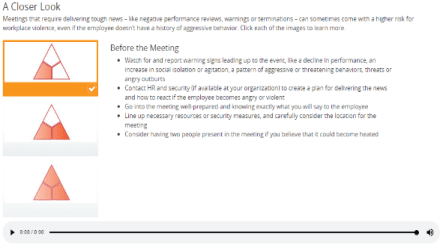Course Preview
At a glance
![]()
Workplace violence and bullying can take many forms, including physical assault, threats, intimidation and vandalism. When incidents happen, they create an unsafe and unprofessional work atmosphere that can erode a positive workplace culture and could put employees and others in danger.
Workplace Violence and Bullying reinforces key concepts to increase employee safety and awareness and help learners uphold an organization’s zero-tolerance commitment. Learners will find out what workplace violence and bullying consist of, as well as ways to recognize and prevent it.
If employees can recognize the signs of violence and abusive conduct – and feel empowered to report it and make positive changes – they will feel more like part of an organizational team committed to productivity and success.
Course Details
All learners
Key concepts covered in this course:
- The definition of workplace violence
- What workplace violence can look like
- Examples of bullying and abusive conduct
- The importance of following organizational policies, including those that prohibit violence, harassment and bullying and those related to physical security
- What emergency action plans do – and why it’s important to understand them
- Internal resources who can help
- Steps for protecting the safety of people and facilities
- Reporting workplace violence
- Common warning signs, including actions and behaviors, perceptions and beliefs, and relationships
- Warning signs of violence when working remotely
- How to respond to warning signs
- Prohibition on retaliation
- Mental health and workplace violence
- Different ways to respond
- De-escalation techniques when confronted by an angry or belligerent person
- The “run-hide-fight” approach for volatile or violent situations, and steps to take once safe
- How to respond to bullying and abusive conduct, whether as a target or bystander
- The importance of a safe workplace
- A reminder to follow policies and procedures
- Staying alert to warning signs
- A reminder of non-retaliation policy
